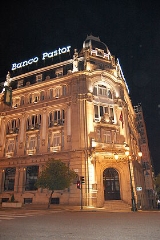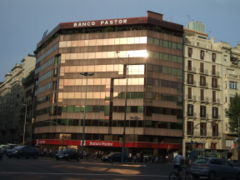
Banco Pastor
Encyclopedia

Spain
Spain , officially the Kingdom of Spain languages]] under the European Charter for Regional or Minority Languages. In each of these, Spain's official name is as follows:;;;;;;), is a country and member state of the European Union located in southwestern Europe on the Iberian Peninsula...
bank. It is the second oldest banking institution in the country, after Banco Etcheverría
Banco Etcheverría
Banco Etcheverría is the oldest bank in the Spanish financial system . It was founded in Betanzos, A Coruña in 1717 by Juan Etcheverry, a French businessman established in Galicia who also created a tanning factory.His family inherited and continued the bank business through generations; the...
.
Founded in 1776 by Jaime Dalmau Batista as Jaime Dalmau y Cía (Jaime Dalmau and Company), who had a shipping company operating between the port
Port
A port is a location on a coast or shore containing one or more harbors where ships can dock and transfer people or cargo to or from land....
of A Coruña
A Coruña
A Coruña or La Coruña is a city and municipality of Galicia, Spain. It is the second-largest city in the autonomous community and seventeenth overall in the country...
and several American ports. Galician emigrants used to send their savings back to Galicia through the shipping company, hence the need to manage all that capital
Financial capital
Financial capital can refer to money used by entrepreneurs and businesses to buy what they need to make their products or provide their services or to that sector of the economy based on its operation, i.e. retail, corporate, investment banking, etc....
.

S.A. (corporation)
S.A. designates a particular type of corporation in various countries, mostly those employing the civil law. It originated in Spain during the 16th century. Depending on language, the abbreviation stands for various phrases meaning anonymous society, anonymous company, anonymous partnership, or...
.
In 1939, Pedro Barrié de la Maza (one of the main economic supporters of the Franco
Francisco Franco
Francisco Franco y Bahamonde was a Spanish general, dictator and head of state of Spain from October 1936 , and de facto regent of the nominally restored Kingdom of Spain from 1947 until his death in November, 1975...
's coup d'état
Coup d'état
A coup d'état state, literally: strike/blow of state)—also known as a coup, putsch, and overthrow—is the sudden, extrajudicial deposition of a government, usually by a small group of the existing state establishment—typically the military—to replace the deposed government with another body; either...
who had received an economic tzar position in Galicia in exchange for his support) took full control of the bank and use it as a supporter of Galician business network control. At a national level it cooperation with Astano, Renfe
RENFE
Renfe Operadora is the state-owned company which operates freight and passenger trains on the 1668-mm "Iberian gauge" and 1435-mm "European gauge" networks of the Spanish national railway infrastructure company ADIF .- History :The name RENFE is derived from that of the former Spanish National...
and Fenosa, founded in 1943 by Barrié de la Maza.
In 1971, after Barrié de la Maza's death, his wife Carmela Arias y Díaz de Rábago was appointed executive president of the bank, being the first woman to do so in Spain. In September 2001 she was succeeded by José María Arias Mosquera.
The bank's main business activity is commercial banking, corporate banking, Internet and telephone banking, and treasury and capital markets. The bank had 4,035 employees as of 2005, 555 branches
Branch (banking)
A branch, banking center or financial center is a retail location where a bank, credit union, or other financial institution offers a wide array of face-to-face and automated services to its customers....
in Spain and 3 abroad.

